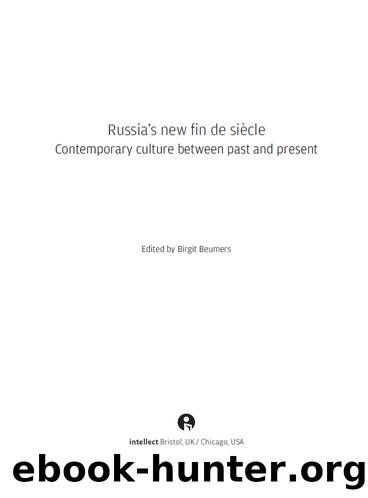Russia's New Fin de Siècle by Birgit Beumers

Author:Birgit Beumers [Beumers, Birgit]
Language: eng
Format: epub
ISBN: 9781783200863
Barnesnoble:
Publisher: Intellect Books Ltd
Published: 2013-07-01T00:00:00+00:00
Market
Тhe transition from a centralized to a free market economy in the 1990s stimulated new forms of distribution. While self-service supermarkets came from the United States to Europe after the Second World War, many of Russiaâs shops preserved traditional distribution over the counter well into the first decade of the twenty-first century. Moreover, the Russian customer often relied on the vendorâs opinion and advice when buying products. This habit dates back to the distribution system before 1917 when the merchantâs choice outweighed the significance of individual brands (Rathmayr 2004: 210). The form of distribution â not only available variety â is crucial to the design, which is either accompanied by the words of the vendor or has to speak for itself in the shelf of the supermarket.
The increase of supermarkets towards the end of the first post-Soviet decade went hand in hand with a rapidly growing Russian chocolate production. Konfety continued to be most popular with consumers, and â sold by weight â took approximately half of the market during the post-Soviet era. They tended to be purchased for own consumption and cost about half the price of chocolates in boxes, usually bought as a gift and supposedly of better quality (Anon. 2006). New brands entered the market, including the domestic Russkii Shokolad (Russian Chocolate) in 1998, where the name and the addition âmade in Russiaâ evokes national pride, and Korkunov in 1999. In 2000 Nestlé successfully introduced the brand Rossiia â Shchedraia Dusha (Russia, the Generous Soul). In 2001 Konfaelâ joined the market with its eccentric chocolate products, including chocolates cast in the shape of pets or portraits.
Interestingly, the high-end brands Korkunov and Konfaelâ did not flirt with Russiaâs past, while high-end restaurants such as Cafe Pushkin, which opened in Moscow in 1999 featuring a neo-Russian style, or the restaurant Russkii Ampir, which opened in 2004 in the completely renovated (rather than restored) premises of a St Petersburg palace, attract well-to-do customers with the exoticism of Russiaâs past.
Download
This site does not store any files on its server. We only index and link to content provided by other sites. Please contact the content providers to delete copyright contents if any and email us, we'll remove relevant links or contents immediately.
| Administration | Assessment |
| Educational Psychology | Experimental Methods |
| History | Language Experience Approach |
| Philosophy & Social Aspects | Reform & Policy |
| Research |
The Art of Coaching Workbook by Elena Aguilar(50722)
Trainspotting by Irvine Welsh(21398)
Twilight of the Idols With the Antichrist and Ecce Homo by Friedrich Nietzsche(18435)
Fangirl by Rainbow Rowell(8993)
Periodization Training for Sports by Tudor Bompa(8080)
Change Your Questions, Change Your Life by Marilee Adams(7546)
This Is How You Lose Her by Junot Diaz(6690)
Asking the Right Questions: A Guide to Critical Thinking by M. Neil Browne & Stuart M. Keeley(5565)
Grit by Angela Duckworth(5438)
Red Sparrow by Jason Matthews(5311)
Paper Towns by Green John(5012)
Room 212 by Kate Stewart(4948)
Ken Follett - World without end by Ken Follett(4581)
Housekeeping by Marilynne Robinson(4233)
The Sports Rules Book by Human Kinetics(4197)
Papillon (English) by Henri Charrière(4132)
Double Down (Diary of a Wimpy Kid Book 11) by Jeff Kinney(4114)
The Motorcycle Diaries by Ernesto Che Guevara(3920)
Exercise Technique Manual for Resistance Training by National Strength & Conditioning Association(3897)
